
Palos de la Frontera is a town and municipality located in the southwestern Spanish province of Huelva, in the autonomous community of Andalusia. It is situated some 13 km (8 mi) from the provincial capital, Huelva. According to the 2015 census, the city had a population of 10,365. It is most famous for being the place from which Columbus set sail in 1492, eventually reaching the Americas.

Martín Alonso Pinzón, was a Spanish mariner, shipbuilder, navigator and explorer, oldest of the Pinzón brothers. He sailed with Christopher Columbus on his first voyage to the New World in 1492, as captain of the Pinta. His youngest brother Vicente Yáñez Pinzón was captain of the Niña, and the middle brother Francisco Martín Pinzón was maestre of the Pinta.
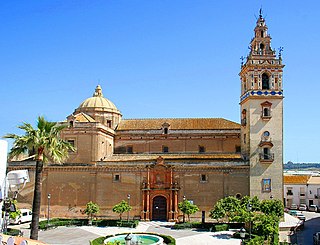
Moguer is a municipality and small city located in the province of Huelva, Andalusia, Spain. According to the 2022 census, it has a population of 22,623. Its surface area is 204 square kilometres (79 sq mi), and its population density is 106.36 per square kilometre (275.5/sq mi).

The Pinzón brothers were Spanish sailors, pirates, explorers and fishermen, natives of Palos de la Frontera, Huelva, Spain. Martín Alonso, Francisco Martín and Vicente Yáñez, participated in Christopher Columbus's first expedition to the New World and in other voyages of discovery and exploration in the late 15th and early 16th centuries.
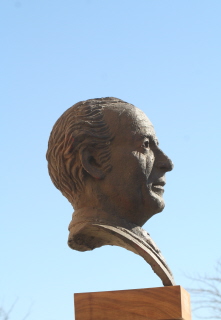
Antonio León Ortega was a Spanish sculptor known for his Andalusian imagery.

The Columbus Monument is a 60 m (197 ft) tall monument to Christopher Columbus at the lower end of La Rambla, Barcelona, Catalonia, Spain. It was constructed for the Exposición Universal de Barcelona (1888) in honor of Columbus' first voyage to the Americas. The monument serves as a reminder that Christopher Columbus reported to Queen Isabella I and King Ferdinand V in Barcelona after his first trip to the new continent.
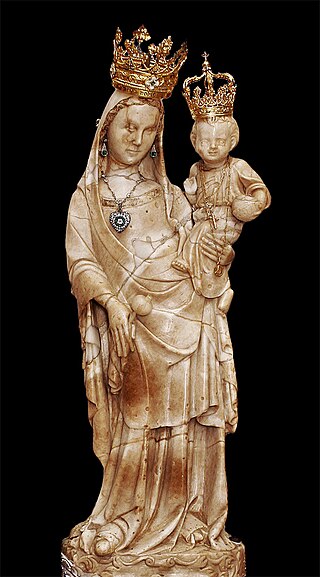
The Virgin of Miracles or Saint Mary of La Rábida is a religious Roman Catholic image venerated at the La Rabida Monastery in the city of Palos de la Frontera.
Julio Izquierdo Labrado is a Spanish writer and holds a doctoral degree. He received his Doctor of History, in collaboration with Lauro Anaya Pena at the I "Martín Alonso Pinzón" International Prize for Historical Research.

The Lugares colombinos is a tourist route in the Spanish province Huelva, which includes several places that have special relevance to the preparation and realization of the first voyage of Cristopher Columbus. That voyage is widely considered to constitute the discovery of the Americas by Europeans. It was declared a conjunto histórico artístico by a Spanish law of 1967.

The Wharf of the Caravels is a museum in Palos de la Frontera, in the province of Huelva, autonomous community of Andalusia, Spain. Its most prominent exhibits are replicas of Christopher Columbus's boats for his first voyage to the Americas, the Niña, the Pinta, and the Santa María. These were built in 1992 for the Celebration of the Fifth Centenary of the Discovery of the Americas. The replica caravels were built between 1990 and 1992, put through shakedown voyages and then, in 1992, sailed the route of Columbus's voyage.

Julio Vicente Agapito Abril Mayorga was a Colombian sculptor, painter, and draughtsman.

Pedro Ruíz Corredor was a Spanish conquistador who participated in the Spanish conquest of the Muisca. He searched for El Dorado, returned to Spain, was sent back to the new world, helped consolidate newly conquered Peru for Spain, retired to his fiefdom to raise a family, and lived to a ripe old age.
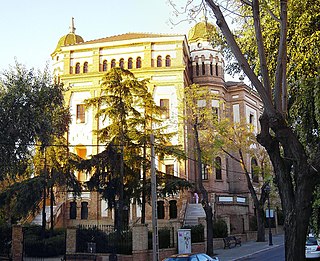
La RábidaHigh School is a public educational center located in the city of Huelva, Andalusia, Spain. It is the institute with more history in all the Province, taking more than 160 years. In addition, the institute is considered a benchmark in education throughout the province. The teaching center has a staff of 60 teachers and more than 1000 students enrolled.

The Monument to Columbus, also known as Monument to the Discovering Faith, is a monument in Huelva, Spain. It is a work by Gertrude Vanderbilt Whitney.

The Monument to Columbus is an instance of public art in Valladolid, Spain. Located on the centre of the namesake Plaza de Colón, in the southeastern corner of the Campo Grande, the monument is dedicated to Christopher Columbus.

The Monument to Columbus is an instance of public art in Salamanca, Spain. The monument, dedicated to Christopher Columbus, is erected on the centre of the namesake plaza.
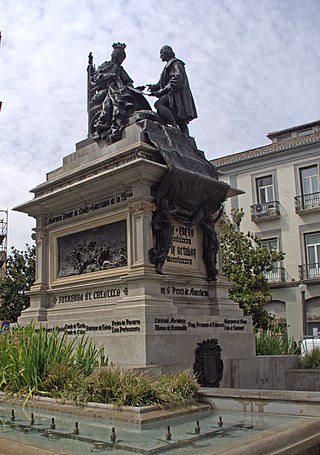
The Monument to Isabella the Catholic also known as the Monumento a Isabel la Católica y Colón or monumento del IV Centenario is an instance of public art in Granada, Spain. Designed by Mariano Benlliure, it consists of a bronze sculptural group depicting a meeting of Isabella I of Castile with Christopher Columbus

The Monument to the Heroes of Puente Sampayo is a memorial and sculptural group created by the Spanish sculptor Julio González Pola, in Pontevedra, Spain.


![Engraving based on a sketch by Juan Comba [es] published in La Ilustracion Espanola y Americana depicting the inauguration of the monument. Inauguracion del Monumento del IV Centenario.jpg](http://upload.wikimedia.org/wikipedia/commons/thumb/1/1a/Inauguraci%C3%B3n_del_Monumento_del_IV_Centenario.jpg/220px-Inauguraci%C3%B3n_del_Monumento_del_IV_Centenario.jpg)
















